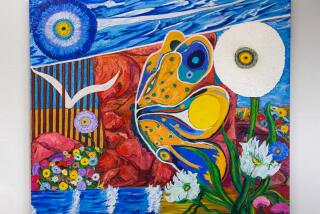Lured by Their Beauty : ART : TROUT: An Illustrated History,<i> By James Prosek (Alfred A. Knopf: $27.50; 158 pp.)</i>
Artistry is essential to fishing. Or so it has been at least since fishermen created their own literature as a Tantric rite to heighten anticipation for tomorrow’s fishing and to prolong the satisfaction of yesterday’s. And to glorify the fishing of the moment.
“Trout as well as eternal salvation come by grace and grace comes by art and art does not come easy,” wrote the late Norman Maclean in the lyrical fishing classic “A River Runs Through It.” He meant the grace and artistry of the fisherman.
As for the trout themselves, Maclean would say, they are big or they are small, they are brown trout or “brookies.” Whichever, “They are beautiful.”
How beautiful? Look.
James Prosek, a 21-year-old Yale undergraduate, has found an uncrowded place in the vast and wonderful literature of trout fishing, the most obvious place of all: the fish as art.
“I searched the library for a volume on trout that was equivalent to Audubon’s works on birds,” Prosek writes in the introduction to “Trout.” “Unable to find any suitable illustration, I set out to do my own under the instruction of our great bird painters.” The result? Seventy-one watercolor plates of America’s native trout, and their adopted European cousin, the brown trout--dressed in all their improbable patterns and colors, from the showy black-and-red of the spawning Arctic Char to the freckled pale pink of the Mexican Rio San Lorenzo Trout.
As Maclean might say, “They are beautiful.”
Prosek painted each fish four times to render it right. The finished paintings are so thorough and evocative that he has been compared favorably to the man who inspired him, John James Audubon, which is as much praise as any young artist could ever hope for.
If Audubon helped us see what we might overlook in birds, Prosek allows us to behold in fish what we otherwise should not. Modern fly-fishing ethics demand as little handling of the fish as humanly possible. It would be unprincipled to keep a fish out of water to contemplate its beauty; better to release it by removing the barbless fly with a flick of the hand and never lift or touch the creature at all--never really see more than a dark back immersed in running water and a flash of broadside color. As a consequence, it is mesmerizing to study at leisure here what we otherwise can only glimpse in the stream.
This book is meditative in another regard, too. For more than a century, fishery managers, and fishermen, tended to look at cold water rivers and lakes as “trout water.” Often any trout would do, or a mix of two or three to pose differing challenges.
So our native fish, along with the introduced brown, have been intermingled, hatched, transported, planted and hybridized willy-nilly, just as their habitat has been altered, degraded and overrun.
Prosek’s work, which includes natural histories of each species and variant, is an eloquent testament to, and plea for, the diversity of these slick, streamlined marvels.
Is there a shortcoming with this book? Other fishermen, I suspect, will join me in noting that a 7-by-10 inch format allows us to contemplate our trout only in modest dimensions. An 8-inch McCloud River Rainbow might be as beautiful as a 20-incher. But by no means equally so.


